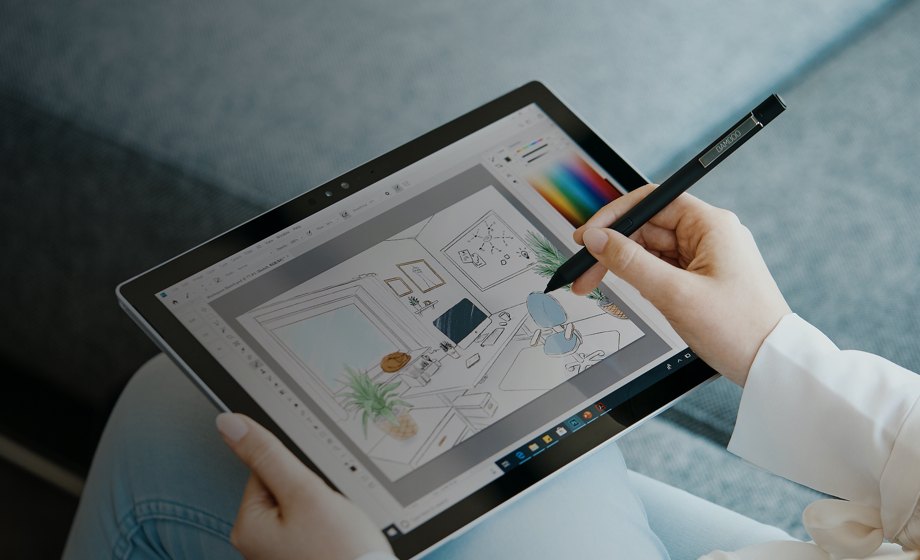Tavolette con penna
Puoi creare bozzetti, disegnare e modificare immagini con un pad reattivo e una penna precisa mentre vedi le tue creazioni prendere vita sullo schermo.


Configurare un'aula online è per gli insegnanti una sfida importante. Come possono insegnare in modo efficace quando alcuni studenti sono fisicamente presenti e altri usano strumenti di e-learning per studiare a distanza? Come si possono gestire al meglio i diversi livelli di coinvolgimento dovuti al nuovo approccio misto? E come si può normalizzare il mondo dell'apprendimento virtuale?
Per affrontare questi problemi, gli insegnanti devono collaborare fra loro in modo efficace. Questo significa creare reti di supporto, condividere idee e avere una buona comprensione delle nuove tecnologie per insegnare online. Di seguito è spiegato come gli insegnanti possono creare e mantenere queste reti con l'evoluzione dell'istruzione e dell'e-learning nei prossimi mesi e anni.

Ora che la rivoluzione dell'e-learning sta prendendo piede, condividere consigli e progetti su come tenere le lezioni online non è più cosi difficile. Bisogna sfruttare al meglio le tecnologie disponibili. Ad esempio, le cartelle condivise, come Google Drive e Dropbox, sono perfette per archiviare i programmi delle lezioni e i modelli dei compiti. Questi ultimi possono essere facilmente condivisi con gli studenti tramite e-mail o videochiamate.
Le cartelle condivise possono essere suddivise in base alla materia, in modo da risultare più facili da individuare. È inoltre utile avere una cartella dedicata agli studi e agli articoli online sull'e-learning e sull'insegnamento con modello ibrido per essere sempre aggiornati ed imparare da persone al di fuori della propria rete di conoscenze. Questo permetterà di sviluppare al massimo le potenzialità degli studenti e di evitare che gli insegnanti debbano ripetere le stesse attività, ad esempio redigere più volte i programmi delle lezioni.

Al termine della pandemia è improbabile che l'e-learning venga abbandonato, quindi ora è il momento ideale per scoprire i migliori strumenti che gli insegnanti hanno a disposizione per tenere lezioni online. Inoltre, questa esplorazione può essere condotta insieme ai colleghi e ad altri insegnanti, usando videoconferenze e webinar per familiarizzare con piattaforme come lavagne virtuali e strumenti didattici interattivi. Affrontando tutto ciò insieme, gli insegnanti possono discutere di tutto quello che riguarda la tecnologia e farsi un'idea di come potrebbe essere applicata alla loro scuola. Questo favorisce anche la possibilità di creare lezioni simili, per aiutare gli studenti a imparare tutti allo stesso ritmo usando le stesse tecniche.
Con una buona comprensione di questi strumenti, gli insegnanti possono spiegare meglio agli studenti come lavorare, il che è di particolare importanza per i ragazzi che prendono in prestito un computer dalla scuola e studiano in modalità virtuale per la prima volta.

In tempi come questi, in cui le riunioni in presenza non sono sempre possibili, conviene usufruire del boom che stanno vivendo gli strumenti di riunione virtuale per trascorrere del tempo con altri insegnanti e condividere esperienze di vita in aula. Quali tecniche consentono di creare condizioni paritarie fra gli studenti in aula e quelli a casa? In che modo gli insegnanti coltivano le relazioni con gli studenti che non vedono ogni giorno, ma con i quali parlano solo online? I nostri display interattivi come Wacom One possono essere di aiuto in entrambi i casi, fungendo da secondo schermo per interagire virtualmente con gli studenti, grazie alla tecnologia intelligente della penna che permette di collaborare e apportare modifiche ai documenti sullo schermo.
Una videochiamata settimanale con lo staff può essere utile anche per portare alla luce problemi di questo tipo e magari per sostituire gli incontri che si tengono in forma più o meno caotica nella sala docenti. Queste riunioni possono aiutare a creare e sviluppare reti di sostegno fra insegnanti e anche a migliorare la qualità delle lezioni.
Wacom One è uno strumento utilissimo per insegnare e collaborare. È anche facilissimo da usare, grazie allo schermo da 13,3" e al fatto che dona la sensazione di usare la penna sulla carta. Ti permette di restare connesso con gli studenti e di condividere idee con altri insegnanti. Collega Wacom One al tuo computer o a determinati dispositivi Android per iniziare subito a lavorare.
Prodotti consigliati

Wacom One 13
Disegna, progetta e crea direttamente su uno schermo ad alta risoluzione con una penna precisa.

Puoi creare bozzetti, disegnare e modificare immagini con un pad reattivo e una penna precisa mentre vedi le tue creazioni prendere vita sullo schermo.

Disegna, progetta e crea con una penna precisa direttamente su uno schermo ad alta risoluzione.

Scrivi con la penna sulla carta e converti in digitale i tuoi appunti manuali.

Scrivi e metti nero su bianco le tue idee sul tuo dispositivo mobile con una penna digitale Wacom.
Wacom 的愿景是通过自然的界面技术汇聚人与科技。这项愿景让 Wacom 成长为交互式数位板、数位屏及数位触控笔的全球性制造商,以及数字签名保存与处理解决方案提供商。Wacom 直观输入设备所采用的技术已催生出全世界诸多一线数字艺术品、电影、特效、时尚及设计佳作,其界面技术同时为商业和家庭用户提供表达自我个性的利器。创办于 1983 年的 Wacom 公司是一家全球性公司,总部位于日本(东京证券交易所上市编号:6727),分公司及营销与销售代表处遍布世界各地 150 多个国家/地区。